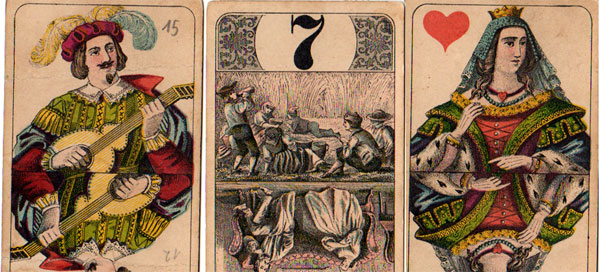C.L. Wüst, 1811 - 1927
SPIELKARTENFABRIEK VON C.L. WÜST, 1811 - 1927. A short history of the Wüst factory by Martin Shaw & Paul Symons.

A short history of the Wüst factory by Martin Shaw & Paul Symons
Conrad Ludwig Wüst was granted permission to establish a business as a card maker in Frankfurt on 19th of September 1811, when he was aged 28. At that time the production of playing cards was just a minor part of the business of manufacturing card. Card was not only produced for other clients, it was also used within the business for the production of items of fashion such as the basis for ornate hat designs for ladies. Gradually the production of playing cards from woodcuts and more particularly high quality fine copper etched examples took on a more important role in the expanding business. The association between Conrad Wüst and the Frankfurt Theatre fitted into the creative world of which he was a part. Popular stars of the stage made ideal, saleable subject matter for quality playing cards.
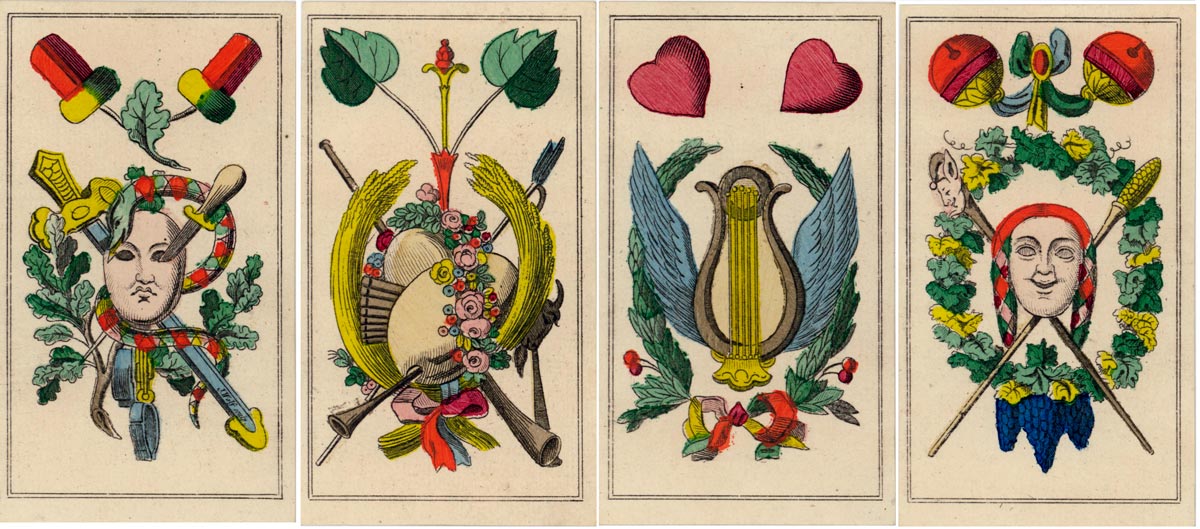
Above: Schiller deck by C. L. Wüst, Frankfurt/Main, depicting figures from different dramas by Schiller, c.1834 see more►
Shortly after Frankfurt’s first railway line opened in 1839, Conrad installed a steam driven press to boost production. Gas that now lit the city streets also provided illumination for Conrad’s workshop allowing for an increase in working hours. At this time he began to employ the new more efficient printing technique of Steindruk or Lithography.
In 1843 at the age of 59, Conrad Ludwig Wüst died. Conrad’s son Caspar Ludwig had completed his apprenticeship in 1841, and despite the fact that his first love was city politics, in 1845, Caspar eventually took responsibility for the Playing Card Factory.
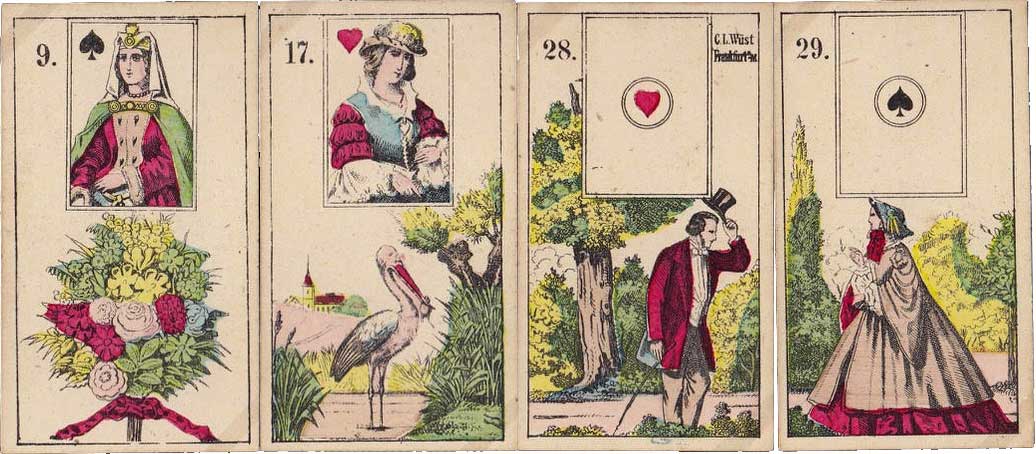
Above: Wüst Lenormand deck, c.1860.
In 1851 at the Great Exhibition at Crystal Palace in England “Caspar Ludwig Wüst, exhibited Playing Cards of various kinds”. Four years later, at the Paris Exposition Universelle, Caspar proudly displayed examples of his work. 1854 saw the declaration of the Crimean War. This conflict led Caspar to prepare a pack of cards on the subject. By this time Wüst’s commercial links were well established not only locally but ranged from Switzerland and down the Rhine to Holland as well many German cities such as Hamburg and Munich. In 1865 a pack of Wüst Cego playing cards illustrating the sharp divide between rich and poor was to become one of Wüst’s most popular productions.

Above: c.1860.
In the late 1860s, Frankfurt am Main opened up areas of land to the West and East of the city. The Wüst family invested in a piece of this ‘new territory’ and in 1871 the foundation stone was laid for an advanced playing card factory. While since 1866 the ‘CLW open Star’ was applied to Wüst playing cards, the Prussians demanded something more permanent. 1876 saw the registration of the first version of the now famous Wüst Star. Ten years later, this was revised and applied to a revitalised range of playing cards.
Wüst prepared cards with the King as a portrait of Caspar Wüst; the Queen as Mathilda Wüst and the Jack, Mathilda’s husband Hermann. In Germany the game of Skat resulted in intense competition between playing card manufacturers. Wüst countered with a unique double figure pack of cards split in the diagonal, the first Wüst standard pattern.
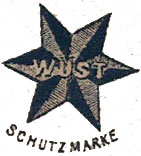
Above: the second Wüst Star trade mark registered in 1884.
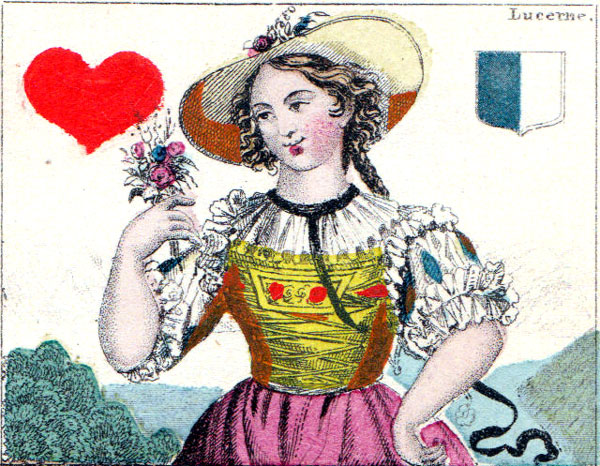
Above: Swiss Costumes, c.1875 see more►
Wüst produced not only a line of traditional Fortune Telling and Cego cards, but also introduced other Card Games. These included a Dominospiel, Frag ünd Antwort-Spiel (Question and Answer), the Kronen Spiel and Padischah (Alphabet Card Game).
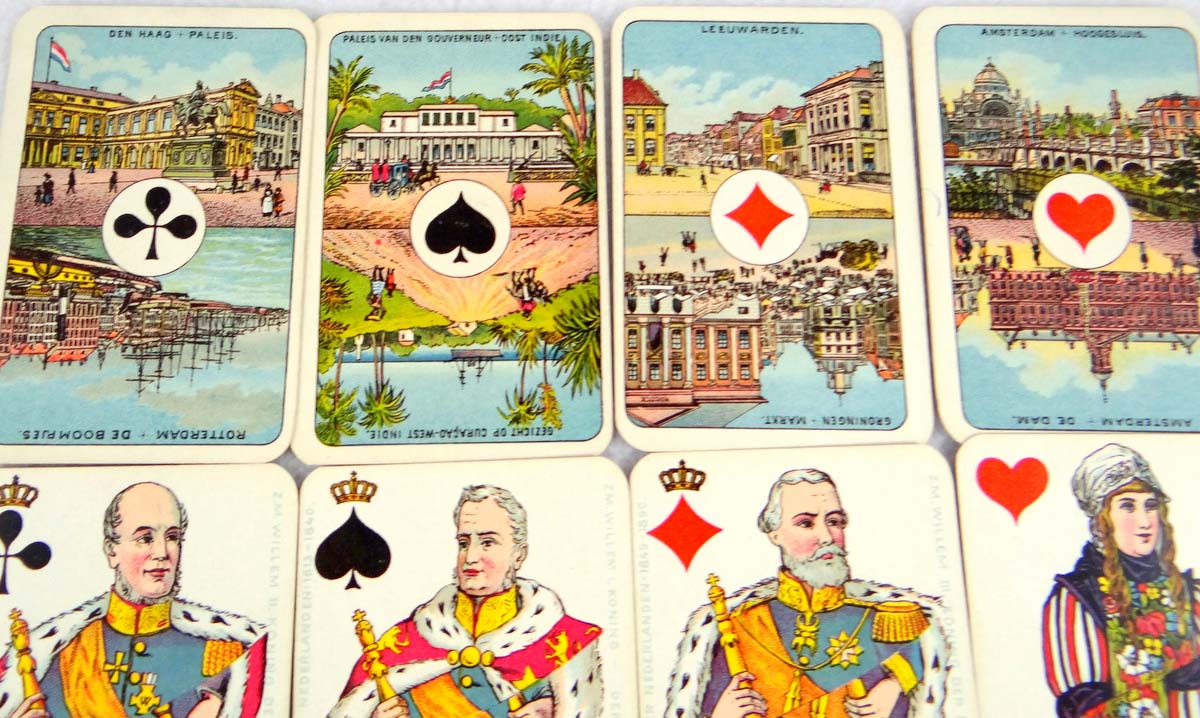
Above: Nationaal Speelkaart Nº 165, c.1905 see more►
Sales and Distribution of Wüst Playing Cards was well structured. The Frankfurt am Main Papier-Kraemer was Wüst’s Agent for Central Germany. In the city of Köln, August Somborn was Wüst’s Agent for Northern Germany. In Würzberg G.M.Neumann was Wüst’s General Agent for Southern Germany. Outlets for playing cards were created in many countries in Europe including the Netherlands, Belgium, Luxemburg, Italy, Spain & Portugal, but also in the Scandinavian countries. On a global scale, Wüst was busy exploring the commercial possibilities within the British Empire. Wüst was able to establish links with London trading houses such as the China & Japan Trading Co. Ltd. and the East and West India Merchants. From their established markets in Brazil and Argentina sales of Wüst Playing Cards followed German émigrés over the high Andes to reach Chile and Peru. In 1898, Caspar Ludwig finally handed the reins of power to his sons Hermann and Georg.
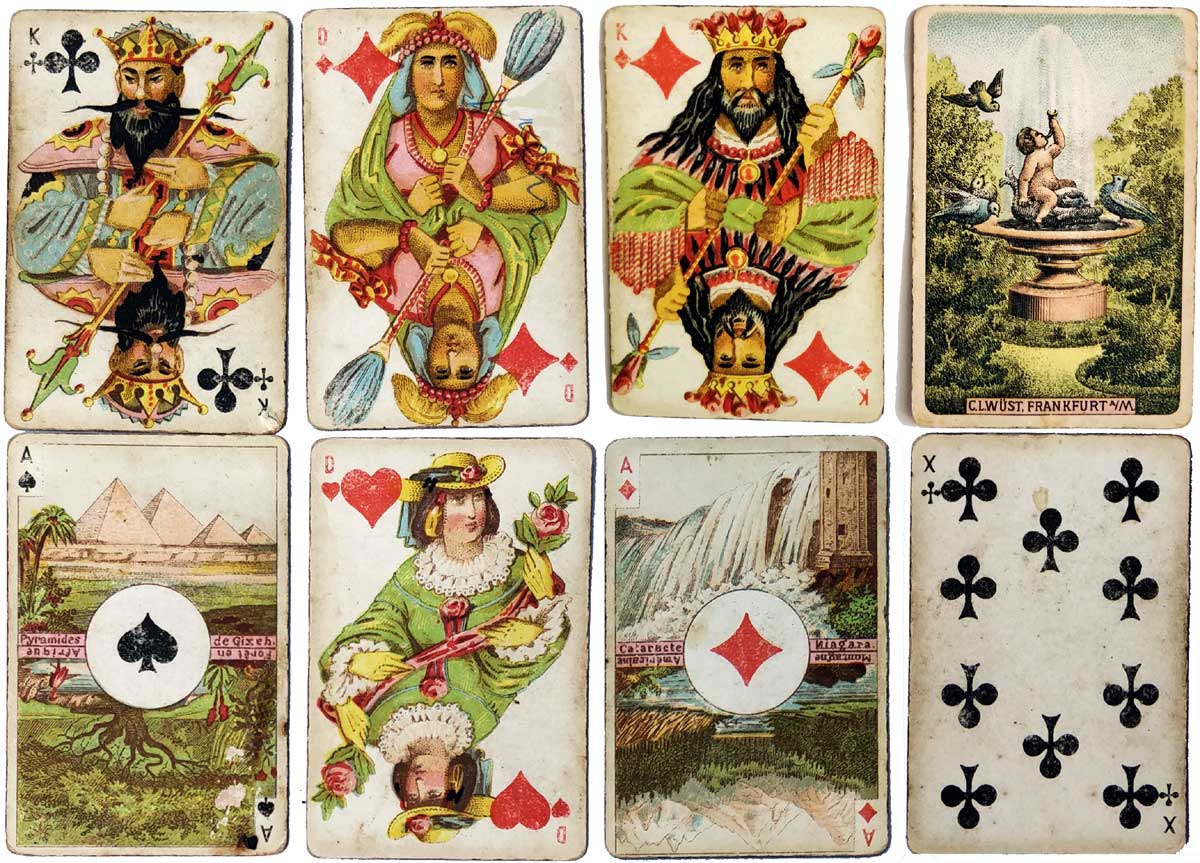
Above: Four Corners of the World Patience representing a different continent on each of the four suits, c.1890. Very similar packs were produced by competing firms, such as Dondorf, Müller and Armanino. Image courtesy Cunie Out.
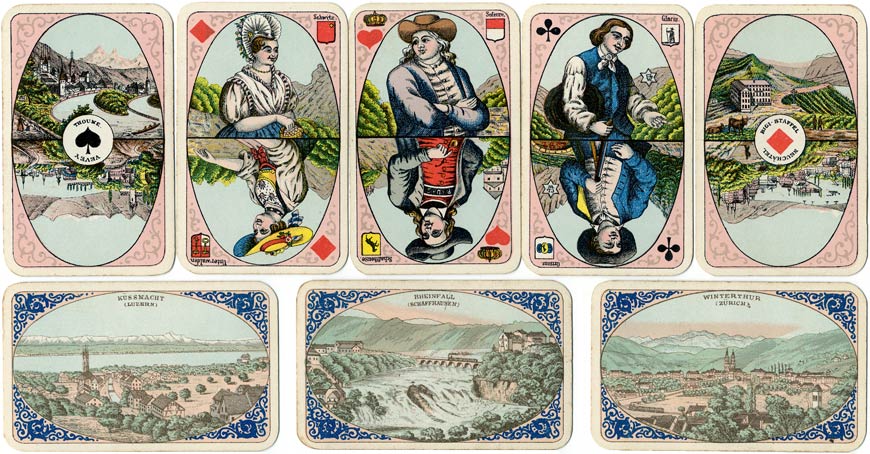
Above: Swiss Album Patience, c.1900 see more►
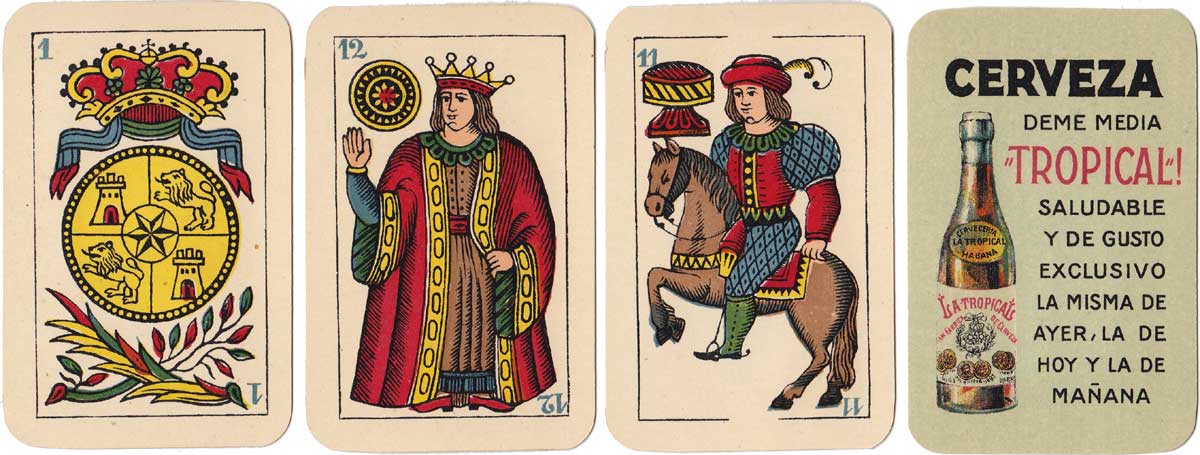
Above: Wüst Spanish pattern deck for export to Cuba, c.1910-1920 see more►
The new Century began well enough for C.L. Wüst. Employing the latest Playing Card manufacturing techniques, 90 employees were producing 5000 packs per day. Sales had grown into an extensive world-wide network with result that over 50% of the company’s production was destined for export. A distant conflict that Wüst chose to commemorate was the Boer War with the issue of the ‘Tansvaal-Kaart’ in 1903. This specially designed pack of cards clearly favoured the Dutch pro-Boer market. Neatly tied with traditional silk thread, Wüst also produced Chinese Money Cards to supply an unusual export market based on the German colony in Tsingtau on the coast of Northern China.
In 1908, at the age of 93, the Grand Old Man Caspar Ludwig Wüst passed on, bringing to an end an era of great personal, political and commercial achievement. His sons Georg and Hermann Wüst continued to look after the interests of the Playing Card Factory C.L. Wüst for a further two years. The brothers then resigned from the company transferring their interest to Hermann’s eldest son Richard Wüst.
With Richard Wüst, born in 1883, at the helm of the Playing Card Factory C.L. Wüst there was every reason to believe that the company would benefit from an injection of youthful energy. A Richard Wüst concept of romantically illustrated Oval Playing Cards was registered in Berlin in 1910. Sales of Wüst products world wide continued to prosper and in 1912 Wüst playing cards were made under licence in the United States. In Germany, a top end of the line pack of Playing Cards was launched, the high quality Luxuskort. Richard had great plans for the company. But in 1914 what would be called the Great War put an end to that. Wüst fell for the fever of war resulting in a noteworthy range of War Playing Cards.
The Pfeiffer pack was issued with the Aces illustrating with remarkable foresight the conditions at the Front. Another classic, but scarce, patriotic Wüst pack ‘Deutsch ist Trumpf’ went so far as to replace normal suit signs with the attributes of war - the German Flag - the Iron Cross - a Shell. Packaging for otherwise standard Wüst playing cards carried slogans ‘Erinnerung aus grosser Zeit’.

Above: ‘Deutsch ist Trumpf’ patriotic deck, c.1915.
The British blockade halted German export trade the Wüst production capacity was filled by an exploding, patriotic home market. When in November 1918 the guns ceased to roar, Richard’s presses joined the silence. Wüst now had to adapt to an uncertain world. Export markets were all but lost. Those that remained were subject to a 20% tariff. Above all, the very basis of the playing card industry, paper, card and ink was hard to come by. Richard Wüst contracted local artists to prepare designs for popular card games such as Schwarzer Peter (Black Peter) and Quartettspiel. With the emphasis now being placed on family games the Wüst standard playing card list was shortened.
In August 1922, Richard Wüst died. Richard’s brother Otto took control, steering the company through the economic turmoil of run-away inflation. The property based company was in fact fairly well placed and emerged relatively unscathed. ‘Stamps’ were then commissioned to grace and act as a seal to Wüst playing card packaging. However, the measure of prosperity and stability that had returned to the Weimar Republic was not enough to enable Otto to make a profit in the playing card business.
Finally in 1927, Otto Wüst negotiated an agreement with the Altenburger Vereinigte Stralsunder Spielkarten-Fabriken A.G. (VSS). Under this accord, production ended in Frankfurt am Main, all of Wüst’s printing material, design rights and most important, Trade Marks became the exclusive property of one of Wüst’s oldest competitors. Otto was appointed to an advisory post with VSS. The History of the Playing Card Factory C.L. Wüst had all but ended.
The latent power of the Wüst acquisitions was such that the company, now Altenburger und Stralsunder Spielkarten-Fabrikanten A.G. (ASS), proudly issued Price lists under the banner ‘Wüstische Sorten’. Trusted Wüst customers in Germany and abroad were forced to turn to ASS.
Text © Martin Shaw & Paul Symons, January 2016
REFERENCES
Shaw, Martin & Symons, Paul: Playing cards from the factory C.L.Wüst, Frankfurt, Germany (1811-1927), Catalogue of the exhibition held at the Nationaal Museum van de Speelkaart, Turnhout, Belgium, 23 September-31 December 2005.
In December of 2005 an exhibition of Playing cards from the factory C.L.Wüst was held in Turnhout, Belgium. There are still a few copies available of the 123 page exhibition catalogue which illustrates 97 decks in colour. A short history of the factory and the descriptions are in English. Copies are available for 30 euros plus postage from Paul Symons who can be contacted by email at paul@symons.nl
Appendix
Wüst’s designs continued to be produced by their successors, V.S.S. The Württemberg pattern shown here has mounted knaves (ober) and is double-ended. The under knave of bells has a satchel on his back.
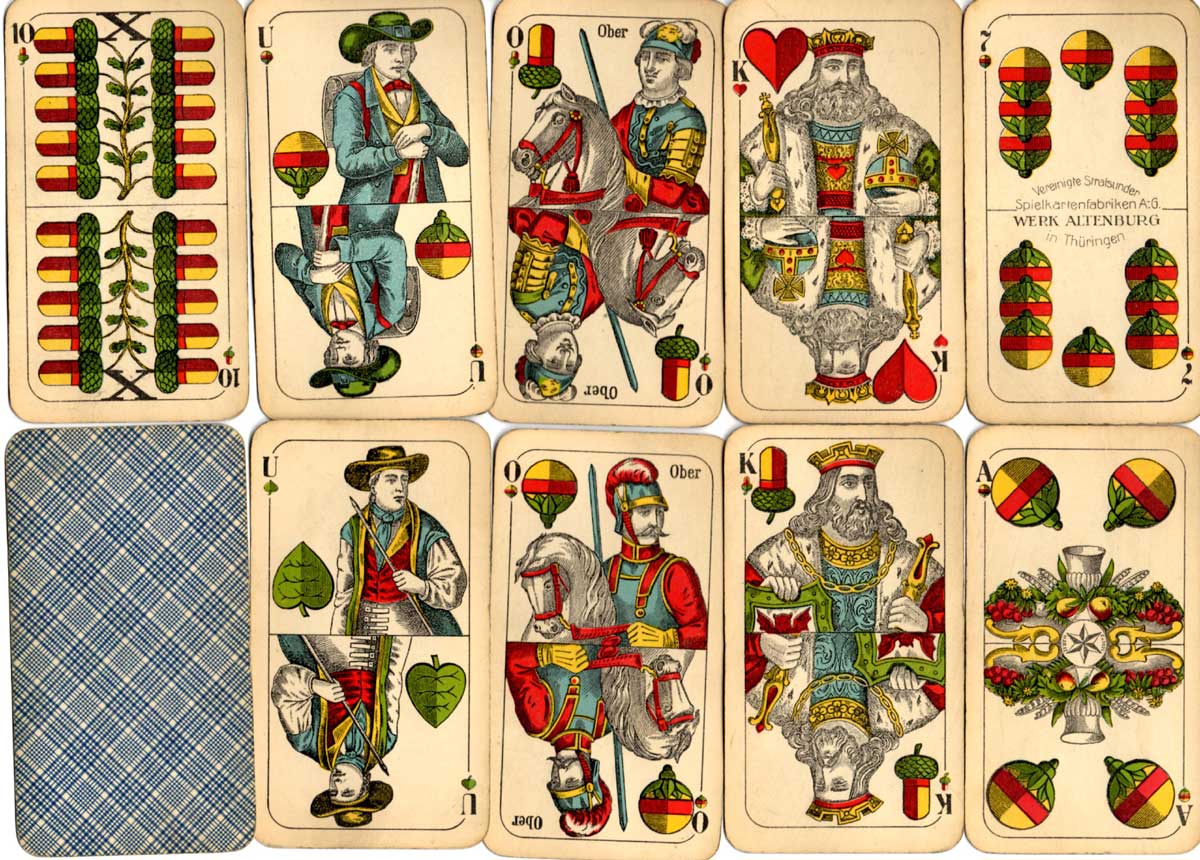
Above: Wüst’s Württemberg pattern produced by their successors, V.S.S., c.1930. Wüst’s Star trade mark can be seen on the Ace of bells and the manufacturer’s details appear on the seven of bells. Image courtesy Melissa Walter.

By Paul Symons
Member since February 01, 2016
I'm British but I have now lived in the Netherlands for more than 50 years and am still enjoying every minute of it. I started collecting playing cards in the early 1980’s after speaking with my neighbour who was at that time a croupier in a casino. I started with just collecting jokers, but that soon led me to complete packs of cards and eventually to specialising in old and antique playing cards, particularly those of C.L. Wüst of Frankfurt, Germany. I am presently the Dutch representative of the I.P.C.S. and the auctioneer at the IPCS conventions.
Related Articles

CARD-AB Miltenberg
Illustrations by Rita Stern depicting notable landmarks and scenes from the town of Miltenberg in Ge...

New Altenburg Skat cards – German DDR Pattern
Authentic Altenburger Skat cards with German suits (Acorns, Hearts, Leaves, Bells).

German Travel Cards
A travel-themed educational deck helping American tourists visiting Germany.

Briefmarken-Quartett
Quartet game featuring postage stamps from the Zones of Occupation in post-WWII Germany.

IG Chemie Papier Keramik
Promotional pack designed by Karl-Heinz Schroers for a German trade union with comical bears on the ...

Engel-Tarot
Set of major arcana designed by Alois Hanslian depicting angels throughout.

Virgil Solis
Remarkable pack of 52 animal-suited playing-cards designed and etched by Virgil Solis.

Politiker-Skat by Bubec
Caricatures of world leaders, including many German politicians, by the artist Bubec.

Le Poker Politique
French politicians and various world leaders caricatured by the German artist Bubec.

Modern Jass (Fredy Sigg)
Caricatural updating of traditional Swiss Jass cards by the artist Fredy Sigg.

Unimog UX 100
Cartoons promoting the Unimog UX 100, a small truck produced by Mercedes-Benz.

Juristenskat
Caricatures of lawyers and judges by Philipp Heinisch for HEEL Verlag.

Battles in Mexico, 1847
Uncut proof sheet with Mexican Battle scenes on the aces and portraits of American generals on the c...

Double-ended German-suited pack by Josef Glanz, Vienna.
From the British Museum collection.

Printing Presses
Antique printing presses from the Turnhout Playing Card Museum collection.

Medizin Skat
Promotional pack for a hospital group in the Saarland, with non-standard suits and courts designed b...
Most Popular
Our top articles from the past 28 days



